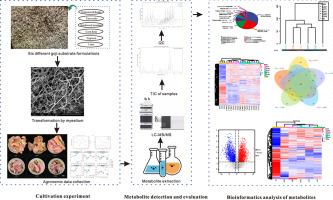枸杞木屑基质上生长的粉色木耳代谢组学研究
IF 9.8
1区 农林科学
Q1 CHEMISTRY, APPLIED
引用次数: 0
摘要
在可持续农业需求的推动下,使用枸杞(枸杞)锯末作为蘑菇栽培的基质可提高生产率,同时减少对环境的影响。本研究评估了不同比例的枸杞锯末对粉红鸡腿菇的生长、产量和代谢特征的影响。共测试了六种基质配方,其中 16% 的枸杞锯末有助于获得最佳产量和质量。基于 LC-MS/MS 的代谢组学鉴定出 1335 种代谢物,主要是有机酸及其衍生物、脂类和类脂分子、有机杂环化合物和苯类化合物。生物标志物分析发现了二十到三十五种与底物变化相关的代谢物。KEGG 富集突出了关键的代谢途径,包括 ABC 转运体、氨基酸生物合成、D-氨基酸代谢和氨基酰-tRNA 生物合成,这些途径都有助于底物适应。本研究有助于深入了解粉红角膜虫对枸杞锯末的代谢反应,未来的研究应结合绝对生物标记物定量,以进一步验证这些结果并优化底物成分。本文章由计算机程序翻译,如有差异,请以英文原文为准。

LC-MS/MS-based metabolomic of pink Auricularia cornea grown on Lycium barbarum sawdust substrate
Driven by the need for sustainable agriculture, using Lycium barbarum (goji) sawdust as a substrate for mushroom cultivation increases productivity while reducing environmental impact. This study evaluates the effects of different proportions of goji sawdust on the growth, yield, and metabolic profiles of pink A. cornea. Six substrate formulations were tested, with 16 % goji sawdust supporting optimal yield and quality. LC-MS/MS-based metabolomics identified 1335 metabolites, mainly organic acids and derivatives, lipids and lipid-like molecules, organoheterocyclic compounds, and benzenoids. Biomarker analysis revealed twenty to thirty-five metabolites associated with substrate variations. KEGG enrichment highlighted key metabolic pathways, including ABC transporters, amino acid biosynthesis, D-amino acid metabolism, and aminoacyl-tRNA biosynthesis, contributing to substrate adaptation. While this study offers insights into the metabolic responses of pink A. cornea to goji sawdust, future research should incorporate absolute biomarkers quantification to further validate these results and optimize substrate compositions.
求助全文
通过发布文献求助,成功后即可免费获取论文全文。
去求助
来源期刊

Food Chemistry
工程技术-食品科技
CiteScore
16.30
自引率
10.20%
发文量
3130
审稿时长
122 days
期刊介绍:
Food Chemistry publishes original research papers dealing with the advancement of the chemistry and biochemistry of foods or the analytical methods/ approach used. All papers should focus on the novelty of the research carried out.
 求助内容:
求助内容: 应助结果提醒方式:
应助结果提醒方式:


